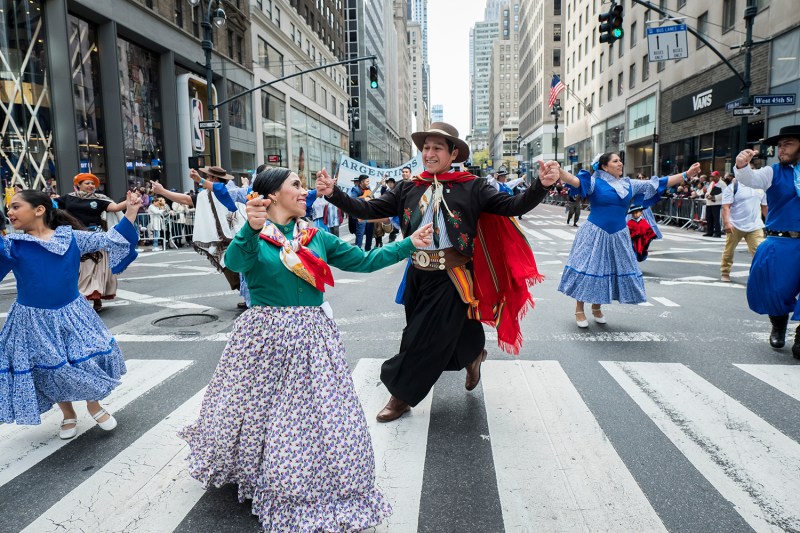September 15th marks the beginning of National Hispanic Heritage Month in America, a month-long celebration filled with food, music, and culture that puts the spotlight on Hispanic people. This includes people who identify as Latinx, Afro-Latinx, Caribbean, or Chicano/Chicana. It’s an emotionally charged topic but today we’re going to go down a rabbit hole history lesson on Hispanic Heritage Month to illuminate why we celebrate the contributions of the Latinx community and how we can further show our appreciation to those who have helped make America what it is today.
According to the U.S. Census, 18.5% of the population identify as Hispanic or Latino with a record 60.6 million in 2019. Hispanic culture is American culture. In fact, the Hispanic community is the largest minority group in the U.S. and has been since before the American Revolution.
From contributing some of the best food on the planet and infectious dance-floor rhythms to providing military service and strong family values, Hispanic culture may only have a month set aside (Sept. 15 to Oct. 15) for honoring its contributions, but it is something we should celebrate every single day.
What is Hispanic Heritage Month?

“Each year, Americans observe National Hispanic Heritage Month from September 15 to October 15, by celebrating the histories, cultures, and contributions of American citizens whose ancestors came from Spain, Mexico, the Caribbean, and Central and South America,” according to the government website.
The celebratory month begins on the 15th because this date marks the anniversary of independence for many Central American countries, including Costa Rica, Nicaragua, and Honduras, and the month encompasses other significant dates of autonomy for such countries as Mexico and Chile.
The commemoration began in 1968 when President Lyndon B. Johnson first enacted Hispanic Heritage Week, which was later expanded to a month-long tribute in 1989.
Ways To Celebrate
National Hispanic Heritage Month is usually celebrated with bright and lively festivals and fiestas, filled with munching on simmering salchichas and Mexican street corn (elotes) while dancing the night away to Cumbia Sonidera. Now we may not be able to attend some celebrations this year due to the ongoing pandemic, but there are still many ways we can celebrate.
You can support Latinx-owned brands such as Latinx designers or you can support restaurants and businesses such as Latinx wineries. You can head down to the local mercado for some authentic Hispanic cuisine, praise local Latinx community members for their dedicated efforts, or further inform yourself on the everlasting bequest Hispanics provide to our society.
Food
Hispanic cuisine is diverse and damn delicious. There are 33 countries in Latin America and the Caribbean. From Mexico’s selection of cuisine such as mole sauce to Argentine BBQ, you’ll quickly find that each country puts forth its own unique flavors and cooking techniques into its dishes. A great way you can celebrate is by setting up a night of flavorful Latin American dishes for you and the family, or even a potluck with some close friends. You can also make it even more immersive by providing a short history of the dish and its origins.
Read More: 10 U.S. Based Hispanic Chefs You Need to Know
Education
One of the best ways to participate in the celebrations is to learn more about Hispanic heritage and culture. There are many avenues for you to choose from, too, whether it be reading literature from renowned Latinx authors, digesting Hispanic art and music, or learning directly from Latinx speakers.
Government programs that pay homage to the festivities:
- Smithsonian Institution: If you’re looking for a deep dive into Hispanic art and artists, the Smithsonian offers an expansive collection ranging from colonial art pieces and religious scriptures to contemporary pieces that both reflect the individualities of Hispanic cultures and their influence on American art and culture.
- The Library of Congress: The public records available at The Library of Congress are amazing resources for crafting a comprehensive diplomatic understanding of National Hispanic Heritage Month. Here you can sift through a complete collection of the various proclamations and statements from former presidents honoring the homage.
- National Park Service: The National Park Service is one of our favorite utilities during National Hispanic Heritage Month because it tells some incredible stories on the history and heritage of the Latinx community and some of its prominent individuals.
Speakers and Scholars:
- Zahira Kelly-Cabrera: Discusses topics of Afrolatinidad, Race & Gender in Latin America, Antiblackness in Latin America, and much more.
- Ruben Angel: Discusses Latinx/Chicanx issues, QTPOC, lived and generational trauma, survivor advocacy, pop culture, social justice, and the ethical application of radical “chisme.”
- Prisca Dorcas: Discusses Surviving White Serving Institutions as a BIPOC, Self Preservation as a First Generation Student, Latinx Families: Generational Trauma, and Sexual Liberation.
Philanthropy
Giving back to these communities that have given so much to our country is another way to show your appreciation. One of the best ways to do so is to support local Hispanic-owned businesses in your area or by donating to one of our favorite Hispanic charities.
- Hispanic Federation: Dedicated to providing educational opportunities for Latinx communities across the nation.
- Hispanic Heritage Foundation: This award-winning charity engages with Hispanic communities to help foster development and preparation in the classroom, workplace, and overall community leadership.
- NALEO Educational Fund: Started in 1981, NALEO is a non-profit that facilitates Hispanic participation in the political process, whether it be mobilizing the community to engage in civic matters or aiding the advancement of Latinx representation in the political atmosphere.
The point of National Hispanic Heritage Month is simple: To pay our respects to the influential and giving Latinx community that has helped shape our culture for centuries.


